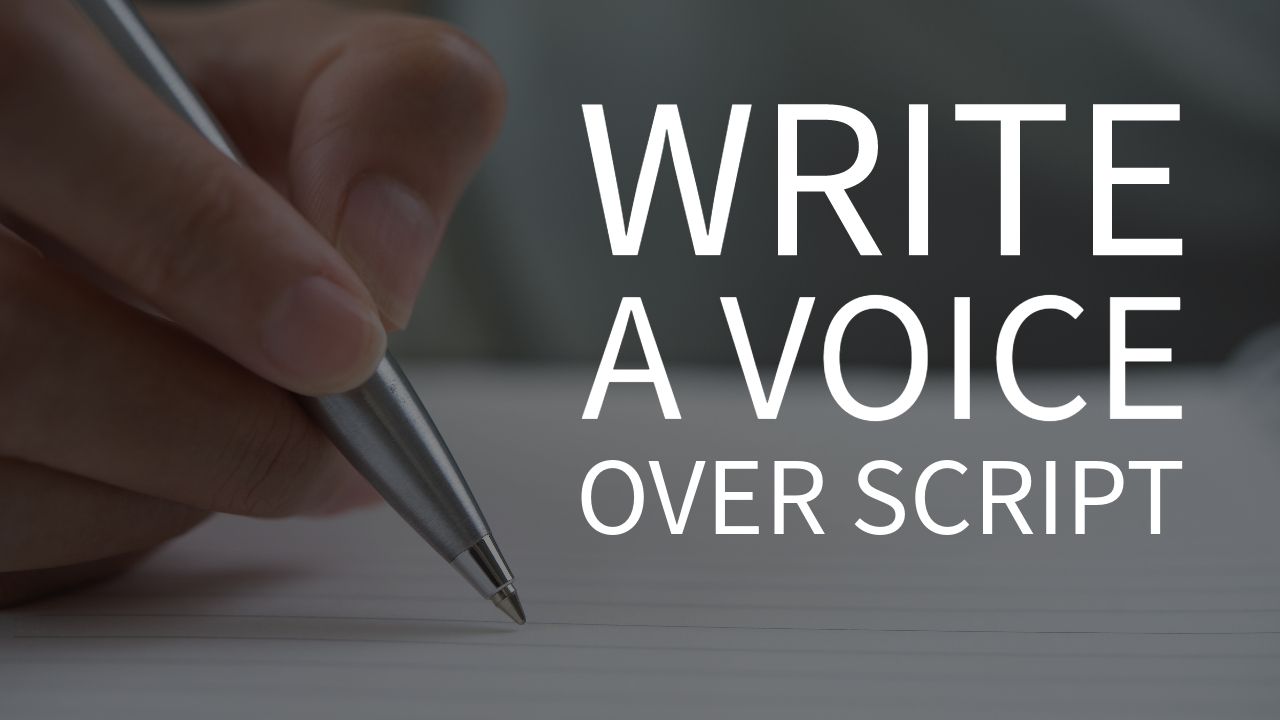How to Write a Voice-Over Script (11 Tips From a VO Expert)
Nov 13, 2023
The Art of the Voice-Over Script
In the bustling hub of media and advertising, the voice you hear is often the guiding star that leads you through a narrative cosmos. Whether it’s the subtle whisper that introduces a thrilling podcast or the energized pitch in a commercial that has you reaching for your wallet, the voice-over binds it all together. But before a voice actor ever steps up to the microphone, someone has to know how to write a voice-over script.
A voice-over script isn’t just a string of words waiting to be spoken. It’s the blueprint of a building before it rises. Behind each memorable voice-over is a meticulously crafted script that ensures the message doesn’t just reach the ears—it resonates with the soul.
Before you start on your next project, review these tips from a VO expert on how to write a voice-over script.
Why a Voice-Over Script Matters
In the symphony of a production, every element, from graphics to sound design, plays its part, but the script conducts the harmony. It dictates the tempo, the highs and lows, the crescendos, and the diminuendos. It is the script that directs the voice actor’s tone, pace, and pitch, ensuring the voice-over doesn’t merely skim the surface but delves deep into the listener’s psyche.
When a project neglects the script, it leads to drab voice-overs, where the words feel like they’ve been plucked from a dusty shelf. In contrast, a well-written script captivates the audience and draws them into the narrative. A poorly written script can lead to disconnect, misinterpretation, or even worse – indifference.
Types of Voice-Over Scripts
Before you can mater knowing how to write a voice-over script, you must first understand its various forms, each distinct in purpose and style. Let’s unpack the array:
- Commercial Scripts
Succinct and persuasive, these scripts aim to captivate and motivate quick consumer action. - Narration Scripts
Informative and descriptive, they provide a guiding voice to visuals in documentaries and presentations. - Explainer Video Scripts
Designed to simplify the complex, explainer video scripts make information approachable and engaging for viewers. - E-Learning and Training Scripts
Focused on education, these scripts are clear and paced to help students learn and understand, especially with the right voice. - IVR/Telephony Scripts
Integral to automated systems, they direct callers with clarity and efficiency through menu options. - Animation and Gaming Scripts
Character-driven and emotionally diverse, these scripts bring life to the animated world and gaming adventures. - Audiobook Scripts
Transforming text to audio, they requires a narrative charm that keeps the listener enthralled. - Podcast and Radio Scripts
These range from structured narratives to free-form conversations designed for engagement. - Promo Scripts
Energetic and impactful, they hook the audience and generate buzz for events or products. - Public Service Announcement (PSA) Scripts
Aimed at raising awareness, they strive to connect with the audience on a social or public concern.
Each script type is a tool tailored to its audio-visual experience, vital for achieving the desired connection with the audience.
11 Tips on How to Write a Voice-Over Script

Crafting the ideal voice-over script transcends mere words; it’s an alchemy of timing, emotion, and expression. Each tip shared here distills years of industry expertise into actionable steps, forming your toolkit for creating scripts that connect and delight.
Understand Your Audience
Stepping into the listener's shoes is the first stride toward creating a voice-over script that resonates. The truth is not all ears are tuned to the same frequency. A script that sings to a millennial might not echo with a boomer, and what delights a tech geek could bewilder a creative artist. Understanding your audience means aligning your script’s wavelength with theirs.
Consider demographics like age, interests, and cultural nuances. This intel informs the language and references you use, ensuring they’re relevant and engaging. If you’re crafting a script for a gaming app aimed at teenagers, your language will be more informal, peppered with current slang, maybe even a meme reference or two. On the flip side, a corporate training module intended for seasoned professionals will command a different vocabulary – authoritative yet accessible.
Keep It Conversational
The allure of a good conversation is undeniable. It’s the verbal dance in which we all partake, and your script should waltz just as well. The key is in the natural ebb and flow of words, which flows effortlessly without stumbling over convoluted sentences or technical jargon that jams the gears of comprehension.
To keep it conversational, your script should read like a dialogue, not a decree. It’s inviting the listener in, not speaking at them. This approach strips away the barriers between the message and the audience, fostering a connection akin to a coffee chat with an old friend. You’re aiming for the nod-along. That means using phrases and sentence structures that feel intuitive, not like they’ve been excavated from a thesaurus.
Embrace Brevity
In a world awash with information, brevity is not just welcome – it’s necessary. Brevity allows you to communicate more while saying less. A voice-over script must distill your message, Every sentence should serve a purpose, be it to inform, persuade, or entertain. It's not about cutting corners; it’s about sculpting your script until it’s lean, potent, and devoid of fluff.
Clarify the Tone
Tone is the subtext that speaks volumes. It’s not just what you say; it’s how you say it. In the hands of the voice actor, tone can transform words into a landscape of emotions. Hence, your script must spell out the desired tonality with as much care as a composer scores a symphony.
Is the voice supposed to ooze excitement or exude calm? Should it inspire awe or provoke thought? These are not mere directorial whims; they are crucial signposts that guide the vocal performance. By articulating the tone, you offer the voice talent a map to the treasure – a performance that hits the emotional mark.
Use Visual Language
Visual language in a voice-over script is the brushstroke that paints images in the listener’s mind. It’s not about being overly descriptive; instead, it’s about using words that trigger the theater of the mind. Good visual language ignites the imagination, allowing the listener to see through their ears.
When you craft a script, think about how words can conjure colors, shapes, and scenes. Your descriptions can guide the inflections and rhythm of the voice artist, helping them to embody the scene. It’s about creating a sensory experience that transcends the auditory channel and taps into the visual psyche of the audience.
Structure with Purpose
Narrative structure in a voice-over script isn’t just about beginning, middle, and end. It’s about crafting a journey that holds the listener’s hand from the first word to the last. A well-structured script possesses a clear path – it knows where it’s going, and more importantly, knows how to take the audience along for the ride.
Think of your script as a building. It needs a solid foundation, supportive walls, and a roof that brings it all together. That means establishing the context upfront, developing the message with consistency, and concluding with a memorable climax. Every script segment should seamlessly transition into the next, maintaining a rhythm that captivates and keeps the listener engaged and eager for the next turn of phrase.
Be Precise with Direction
Precision is the guiding star regarding direction in a voice-over script. It’s about creating a blueprint that the voice talent can confidently follow. That means being meticulous with how you want specific phrases to be delivered, where to pause for effect, and which words deserve the spotlight.
In the fabric of your script, sew in the pauses – the breaths that give rhythm to the speech. Highlight the words that need to stand out as if they are pulling the listener closer. It’s not just about being heard; it’s about being felt. When you notate emphasis, pauses, and tone, you are essentially conducting an orchestra where the voice is the lead instrument, playing a song of persuasion and engagement.
Reflect Brand Personality
Every brand has a persona, a unique voice that echoes its values and ethos. When you weave the script, infuse it with the threads of the brand’s personality. It's not about slapping a logo onto the words; it’s about ensuring the script embodies the character and spirit of the brand.
If the brand were a person, how would it speak? What would be its tone, its quirks, its warmth? Your script should mirror the brand’s identity, from its sense of humor to its level of formality. By doing so, you’re not just delivering a message; you’re extending an experience of the brand itself to the listener.
Prioritize Clarity
Clarity is the cornerstone of comprehension. In the realm of voice-over scripts, it’s essential to break down complex ideas into digestible pieces. That doesn’t mean diluting the content; it means refining it. Your goal is to craft a message that is accessible without being condescending and informative without being dense.
Employ simplicity as your ally. If a concept is intricate, use analogies or examples that illuminate rather than obfuscate. Remember, if the listener has to rewind mentally, you’ve lost the immediacy of the message. Clarity ensures your script can be grasped by anyone, regardless of their prior knowledge on the subject.
Experiment with Cadence
Cadence – the rhythm of your script – gives it musicality and motion. An unvarying cadence can render even the most compelling script monotonous. Hence, play with the pacing like a maestro, varying sentence lengths and structures to create a dynamic auditory experience.
Short, punchy sentences can quicken the pulse of the piece, infusing it with energy. Conversely, longer sentences can slow the pace, allowing for reflection or anticipation. This interplay of speeds keeps the listener engaged, riding the waves of your script’s cadence with sustained interest.
End with a Call to Action
The finale of your voice-over script should be more than just a closing statement; it should be a launchpad that propels the listener toward action. A well-crafted call to action (CTA) doesn’t just suggest; it inspires the listener to take the next step. It’s the bridge between the message and the response you seek.
Ensure your CTA is clear, compelling, and relevant. It should resonate with everything the listener has just heard and provide them with a clear path forward. Whether it’s inviting them to learn more, to join a community, or to take advantage of an offer, your CTA is the decisive nudge that turns passive listening into active engagement.
Bring Your Script to Life with Academy Voices

Once you know how to write a voice-over script, you need the vocal talent to bring your words to life. This fusion of a meticulously crafted script and the nuanced delivery of a skilled voice actor is the crucible where auditory magic happens.
Academy Voices is your ally in this creative process, providing a roster of exceptional talent to breathe life into your script. With a keen understanding of the nuances that elevate an excellent performance to a great one, the voice actors ensure your message isn’t just heard but felt. When the time comes to give your script a voice, consider Academy Voices as the gateway to providing your words leave the lasting impact they deserve.
Get a Complimentary Quote



